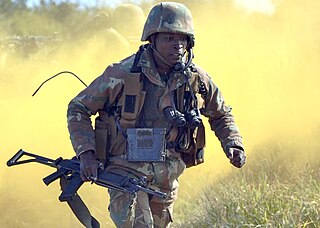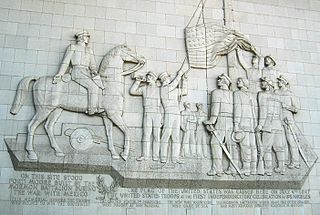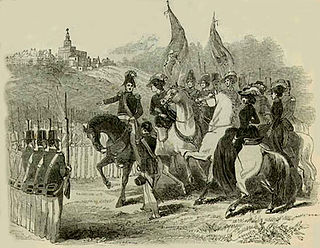Robert Clift Jr. (January 4, 1824 – October 1859) was an American soldier and early settler in California.

The United States of America (USA), commonly known as the United States or America, is a country composed of 50 states, a federal district, five major self-governing territories, and various possessions. At 3.8 million square miles, the United States is the world's third or fourth largest country by total area and is slightly smaller than the entire continent of Europe's 3.9 million square miles. With a population of over 327 million people, the U.S. is the third most populous country. The capital is Washington, D.C., and the largest city by population is New York City. Forty-eight states and the capital's federal district are contiguous in North America between Canada and Mexico. The State of Alaska is in the northwest corner of North America, bordered by Canada to the east and across the Bering Strait from Russia to the west. The State of Hawaii is an archipelago in the mid-Pacific Ocean. The U.S. territories are scattered about the Pacific Ocean and the Caribbean Sea, stretching across nine official time zones. The extremely diverse geography, climate, and wildlife of the United States make it one of the world's 17 megadiverse countries.

A soldier is one who fights as part of an army. A soldier can be a conscripted or volunteer enlisted person, a non-commissioned officer, or an officer.

California is a state in the Pacific Region of the United States. With 39.6 million residents, California is the most populous U.S. state and the third-largest by area. The state capital is Sacramento. The Greater Los Angeles Area and the San Francisco Bay Area are the nation's second- and fifth-most populous urban regions, with 18.7 million and 8.8 million residents respectively. Los Angeles is California's most populous city, and the country's second-most populous, after New York City. California also has the nation's most populous county, Los Angeles County, and its largest county by area, San Bernardino County. The City and County of San Francisco is both the country's second-most densely populated major city after New York City and the fifth-most densely populated county, behind only four of the five New York City boroughs.
Clift was born in Dymock, England to Robert Sr. and Elizabeth Clift, who would later convert to Mormonism and emigrate to the United States.

Dymock is a village and civil parish in the Forest of Dean district of Gloucestershire, England, about four miles south of Ledbury. The parish had a recorded population of 1,214 at the United Kingdom Census 2011.

Mormonism is the predominant religious tradition of the Latter Day Saint movement of Restorationist Christianity started by Joseph Smith in Western New York in the 1820s and 30s. After Smith was killed in 1844, most Mormons followed Brigham Young on his westward journey to the area that became the Utah Territory, calling themselves The Church of Jesus Christ of Latter-day Saints. Other sects include Mormon fundamentalism, which seeks to maintain practices and doctrines such as polygamy, and other small independent denominations. The second-largest Latter Day Saint denomination, the Reorganized Church of Jesus Christ of Latter-day Saints, since 2001 called the Community of Christ, does not describe itself as "Mormon", but follows a Trinitarian Christian restorationist theology, and considers itself Restorationist in terms of Latter Day Saint doctrine.
He was 3rd Lt. in Company C of the Mormon Battalion. The Battalion marched from Council Bluffs, Iowa to San Diego during the Mexican-American War. The Battalion arrived in San Diego in January 1847 but were too late for the war. They performed community improvement projects that endeared them to the local population, who were initially wary of the Battalion.

The Mormon Battalion, the only religion-based unit in United States military history, served from July 1846 – July 1847 during the Mexican–American War of 1846–1848. The battalion was a volunteer unit of between 534 and 559 Latter-day Saints men, led by Mormon company officers commanded by regular U.S. Army officers. During its service, the battalion made a grueling march of nearly 2,000 miles from Council Bluffs, Iowa, to San Diego, California.

Council Bluffs is a city in and the county seat of Pottawattamie County, Iowa, United States. The city is the most populous in Southwest Iowa, and forms part of the Omaha (Nebr.) Metropolitan Area. It is located on the east bank of the Missouri River, across from the city of Omaha. Council Bluffs was known, until at least 1853, as Kanesville. It was the historic starting point of the Mormon Trail. Kanesville is also the northernmost anchor town of the other emigrant trails, since there was a steam powered boat to ferry their wagons, and cattle, across the Missouri River.

San Diego is a city in the U.S. state of California. It is in San Diego County, on the coast of the Pacific Ocean in Southern California, approximately 120 miles (190 km) south of Los Angeles and immediately adjacent to the border with Mexico.
When they were about to be discharged in July 1847, the citizens of San Diego signed a petition requesting that they re-enlist for additional duty, and many, including Clift, did.
From June 1847 to March 1848, Clift was Juez de Pas (Justice of the Peace) of San Diego Pueblo. John Vurtinus, in an article, [1] states that Clift:
also served as the Acting Assistant Quartermaster and Commissary Officer with orders to accumulate a full six months' supply of rations. Since his requisitions were never filled completely, stock-piling of rations remained Clift's most persistent problem. Although the San Diego garrison nearly ran out of provisions during October, Clift managed the difficult situation well and generally supplied full rations to the men. Colonel Stevenson thought highly of Robert Clift, calling him the most competent Latter-day Saint officer in the Mormon Volunteers.
The Substitute Alcalde (Suplente), Henry D. Fitch had pressing business in Los Angeles, so he recommended Clift be appointed Substitute Alcade in his place in June 1847, a post he held until later that year. In a letter from California Military Governor Richard B. Mason he writes: [2]

Henry Delano Fitch was an American born Mexican sea captain and trader. He was an early settler of San Diego, California. In San Diego, he was the first attorney, created the first survey of pueblo lands in the region, and served as mayor of the city from 1846-1847.

Los Angeles, officially the City of Los Angeles and often known colloquially by its initials L.A., is the most populous city in California and the second most populous city in the United States, after New York. With an estimated population of four million, Los Angeles is the cultural, financial, and commercial center of Southern California. Nicknamed the "City of Angels" partly because of its name's Spanish meaning, Los Angeles is known for its Mediterranean climate, ethnic diversity, Hollywood, and the entertainment industry, and sprawling metropolis.
While at San Diego Capt Fitch the Alcalde expressed great anxiety to resign his place if not permanently for a short time that he might go north on business of the utmost importance to himself, he applied to me to sanction his appointment of Lt. Clift of the Mormon Battalion A. Lt. Master & Commissary of that Post as acting Alcalde during his temporary absence; I was well informed that under Mexican laws an Alcalde has the power of appointing a temporary successor under sanction of the Commander of the District. I endorsed my approval upon Clift's appointment being well satisfied that he was a very proper person and a great favorite in the town, and if he should reenter the Service and he can with propriety be appointed Alcalde permanently in the place of Fitch I would respectfully recommend it. From all I can learn the mode of transacting business by the Alcalde here differs materially from those practiced at San Francisco and Monterey—for instance here there are no trials by Jury . . .
Using custom duties, Clift received permission from Governor Mason to build a brick building that was used as a courthouse, schoolhouse, and later office for Mayor, City Clerk, and County Board of Supervisors. This was the first fired-brick building in San Diego. The courthouse was reconstructed in 1992 from the ground up and is located in the South corner of the square in Old Town State Park.
In 1851 Clift and about twenty other Mormons bought land and moved near the Cajon Pass, San Bernardino County. When San Bernardino County was organized January 1853, he was elected the first County sheriff. He was Captain of the First Light Dragoons, a militia unit formed in the county in 1856. In 1857 the Mormons were recalled to Utah, due to difficulties with the U.S. Government in Utah, and Clift likely followed.
In 1859 Clift was a sub-agent for the California & Salt Lake Mail Route. He was reportedly killed by Indians near the Humboldt River while scouting a path to connect the older California Trail with the new Simpson's Route across Nevada. [3] [4]










